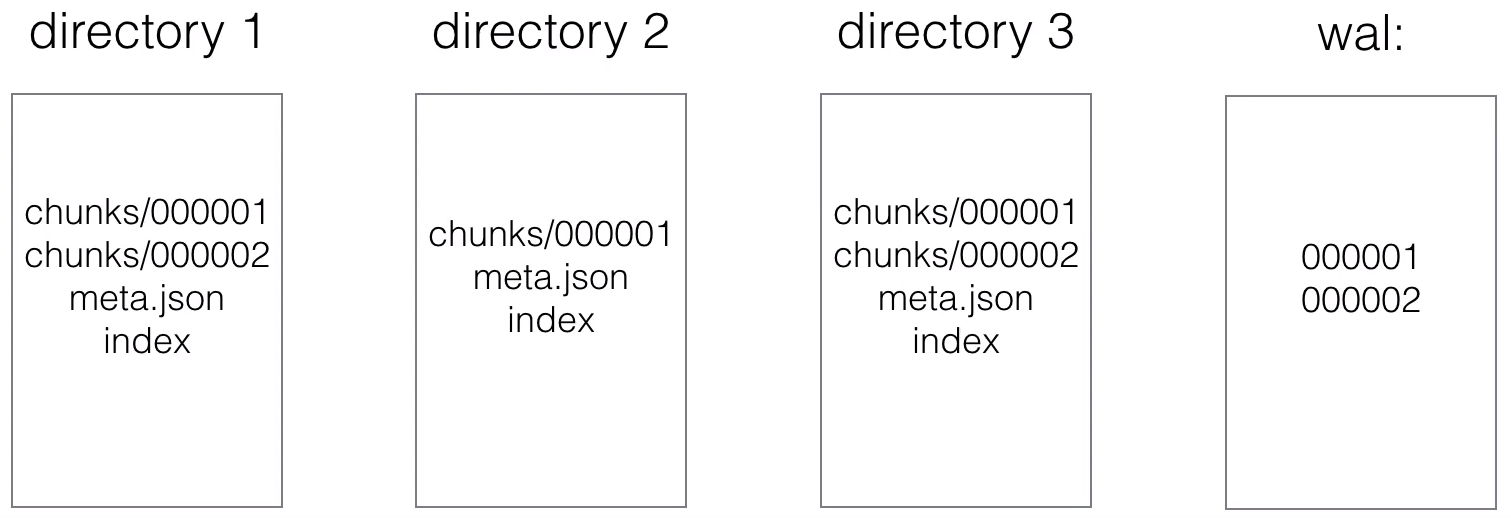Storage
- You can use the default local on-disk storage, or optionally the remote storage system
- Local storage: a local time series database in a custom Prometheus format
- Remote storage: you can read/write samples to a remote system in a standardized format
- Currently it uses a snappy-compressed protocol buffer encoding over HTTP, but might change in the future (to use gRPC or HTTP/2)
Local Storage
- Prometheus >= 2.0 uses a new storage engine which dramatically increases scalability
- Ingested samples are grouped in blocks of two hours
- Those 2h samples are stored in separate directories (in the data directory of Prometheus)
- Writes are batched and written to disk in chunks, containing multiple data points
- Every directory also has an index file (index) and a metadata file (meta.json)
- It stores the metric names and the labels, and provides an index form the metric names and labels to the series in the chunk files
- The most recent data is kept in memory
- You don't want to loose the in-memory data during a crash, so the data also needs to be persisted to disk. This is done using a write-ahead-log (WAL)
- Write Ahead Log (WAL)
- it's quicker to append to a file (like a log) than making(multiple) random read/writes
- If there's a server crash and the data from memory is lost, then the WAL will be replayed
- This way no data will to lost or corrupted during a crash
- When series gets deleted, a tombstone file gets create
- The initial 2-hour blocks are merged in the background to from longer blocks
- This is called compaction
- The horizontal partitioning gives a lot of benefits:
- When querying, the blocks not in the time range can be skipped
- When completing a block, data only needs to be added, and not modified (avoids write-amplification)
- Recent data is kept in memory, so can be queried quicker
- Deleting old data is only a matter of deleting directories on the filesystem.
- Compaction:
- When querying, blocks have to be merged together to be able to calculate the results
- Too many blocks could cause too much merging overhead, so blocks are compacted
- 2 blocks are merged and form a newly created (often larger) block
- Compaction can also modify data:
- dropping deleted data or restructuring the chunks to increase the query performance
- The index:
- Having horizontal partitioning already makes most queries quicker, but not those that need to go through all the data to get the result
- The index is an inverted index to provide better query performance, also in cases where all data needs to be queried
- Each series is assigned a unique ID (e.g. ID 1,2 and 3)
- The index will contain an inverted index for the labels, for example for label env=production, it'll have 1 and 3 as IDs if those series contain the label env=production
- What about Disk size?
- On average, Prometheus needs 1-2 bytes per sample
- You can use the following formula to calculate the disk space needed:
needed_disk_space = retention_time_seconds * ingested_samples_per_second * bytes_per_sample
- How to reduce disk size?
- You can increase the scrape interval, which will get you less data
- You can decrease the targets or series you scrape
- Or you can can reduce the retention (how long you keep the data)
--storage.tsdb.retention: This determines when to remove old data. Defaults to 15d
Remote Storage
- Remote storage is primarily focused at long term storage
- Currently there are adapters available for the following solutions:
AppOptics: write Graphite: write Chronix: write InfluxDB: read and write Cortex: read and write OpenTSDB: write CreateDB: read and write PostgreSQL/TimescaleDB: read and write Gnocchi: write SignalFx: write Source: https://prometheus.io/docs/operating/integrations/@remote-endpoints-and-storage
References
- To read the full story of Prometheus time series database, read the blog post from Fabian Reinartz at https://fabxc.org/tsdb/




2 Comments
Anonymous
Anonymous